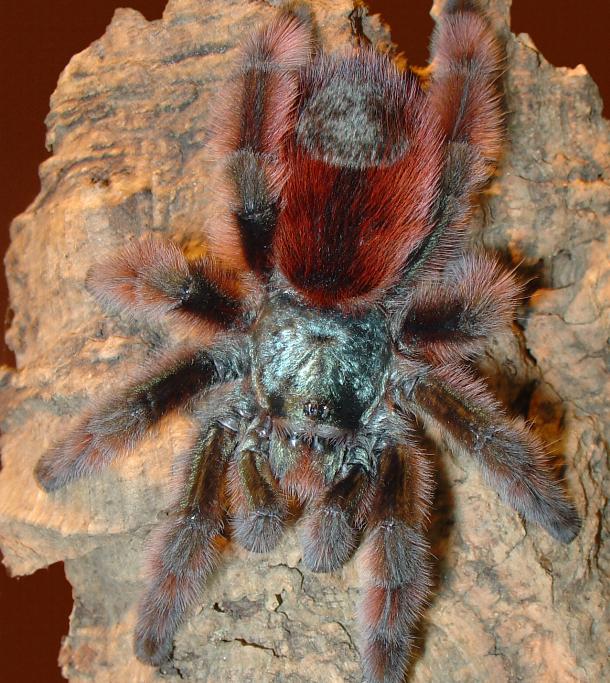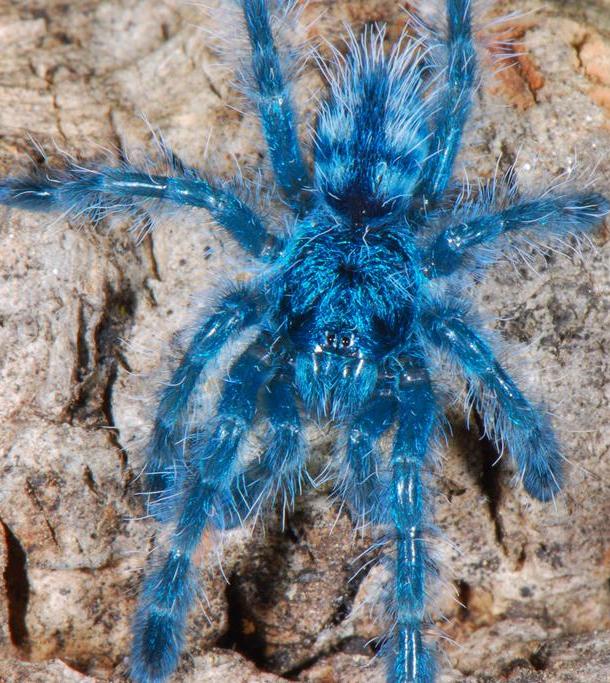GROWING YOUR OWN
LAST UPDATED ON 2013-July-03!
 |
| Avicularia versicolor, mother (above) and baby (below), with great thanks to Patrick Mumford for supplying the tarantulas. |
 |
- DEFINITION: DLS
- Diagonal Leg Span
- The linear distance between the tip of one front leg to the tip of the rear leg on the opposite side when the tarantula is in a normal resting posture.
Yes, we know it's not very accurate. But, we're not competing for Olympic gold medals or a new car. All we want is an estimation of how large or small your tarantula is.
|
Ours is bigger than your's is!
Neener. Neener. Neeeee-ner!
|
PROPOSED DEFINITIONS
We propose the following definitions of commonly used and misused terms in the arachnoculture hobby. These are the definitions used in the following discussion.
- Baby
- Any tarantula from the time that it has shed its chorion in the eggsac up until it has begun to acclimatize to adult care conditions. Use of this term infers that the tarantula has not yet developed a fully functional waxy layer in or on its epidermis, and still requires "baby" conditions, especially a high humidity.
- Tween
- Any tarantula from the time that it begins to acclimatize to adult care conditions until it has completed that acclimatization. This term infers that the tarantula is "in progress" of developing the waxy layer in its epidermis. This status usually only lasts for two or three molt cycles. A few kinds of tarantulas (e.g., the "obligate" swampers) may not experience this transitionary phase.
- Spiderling
- Any tarantula that has completed the acclimatization to adult conditions but whose molt cycle has not yet lengthened to one or fewer molts per year. Use of this term implies that the acquisition of a fully functional waxy layer in the epicuticle is complete and the tarantula (for most ) kinds no longer requires excessive attention to humidity.
- Juvenile
- Any spiderling that is larger than approximately half grown. Note that in the context of these definitions, "juvenile" is a subdivision of "spiderling."
- Adult
- Any tarantula whose molting cycle has lengthened to one or fewer molts per year.
- Mature or Mature Adult
- Any "adult" tarantula that is sexually mature by any of several tests.
GROWING YOUR TARANTULA
CAVEATS
Note that the following rules of thumb apply to nearly all tarantulas except a few obligate swamp dwellers, and to the arboreal species. Those are addressed towards the bottom.
BABY TARANTULAS
Those younger tarantulas with a DLS of about 1.5" (38 mm) or less should be kept in a relatively closed container that heavily restricts ventilation. The substrate should be kept slightly damp. All this maintains a constant, elevated (but not excessive) humidity. Do not mist; instead, reread the last few sentences carefully. Do not spend a lot of time, energy, effort, or money on fancy containers. Like humanoid babies, these will outgrow their containers soon, thereby wasting all your finest efforts over and over again.
SPIDERLINGS TO ADULTS
Those younger tarantulas with a DLS of about 2" (50 mm) and larger should be kept in cages with dry substrate and supplied a water dish with clean water. Keep almost all of these as arid species. (See the exceptions below.)
TWEENS
Those tarantulas BETWEEN the aforementioned two sizes should be gradually acclimatized to a dry cage over a period of 2 or 3 molts. Gradually allow the container/cage to dry out, but be very sure to supply a water dish with clean water. You're gradually removing the higher humidity and substituting a water dish as the primary water source. In response, the tarantula develops a thicker, more impervious waxy layer to prevent excessive water loss from its body. All it needs is a little time to adjust.
Note that many tarantulas from semi-arid and arid places like the American Great Plains and the Kalahari Desert can make this transition much earlier in life than these recommended times. But, it does them no harm to wait a little longer either.
SWAMP DWELLERS
These are the WILD CAUGHT individuals of species like Theraphosa, Ephebopus, Hysterocrates, Megaphobema, and possibly others. These do not have the impervious, water retentive exoskeletons of the other tarantulas and require a constant, high humidity. Keep these in "baby" style cages for their entire lives, adjusting for increased size of course.
Enthusiasts are discovering that wild caught "swampers" will gradually develop a somewhat greater resistance to slightly drier conditions if the transition is done slowly and over an extended period of time. And, those swampers that are bred in captivity fare much better and can tolerate drier cages much better than their wild caught brethren from the outset. Members of the genus Ephebopus are a good case in point.
ARBOREALS
WILD CAUGHT arboreals (assumed to be adults), particularly members of the genus Avicularia often fare poorly when first brought into captivity, partly because of "shipping shock" and partly because of the sudden change in environmental conditions. To combat this, they should be initially set up and cared for as babies for the first few weeks (initial recovery period), then quickly switched to a "Tweens" care regimen (secondary acclimatization period) for the first one or two molts. Thereafter keep them as adult, arid tarantulas but maintain a slightly elevated humidity by slightly restricting ventilation. Always supply them a water dish. (In the middle of the night as they hunt for food they'll pussyfoot down to the water dish and take a sip. And being sound asleep, you'll never, EVER know it happened!)
CAPTIVE BRED arboreals (assumed to be babies or very young spiderlings) usually do not suffer the acclimatization problems that the wild caught ones do, but sometimes suffer shipping shock from bad treatment during transportation. When first received they should be kept as babies (see above) for two or three weeks, then they can be quickly changed over to whatever care regimen is appropriate according to the schedule given here, depending on their size and age.
NAVIGATION
Click the "BACK" button to return to the page from which you came.
Jump to the top of this page.
Jump to the Motorhome webpage.
Jump to the Spiders, Calgary webpage.
Jump to the Index and Table of Contents for this website.
COMMUNICATIONS
Communicating with us is easy. Just select here.
COPYRIGHT NOTICE
Copyright © 2013, Stanley A. Schultz and Marguerite J. Schultz.
Select here for additional copyright information.
This page was initially created on 2013-March-08.
The last revision occurred on 2013-July-03.

